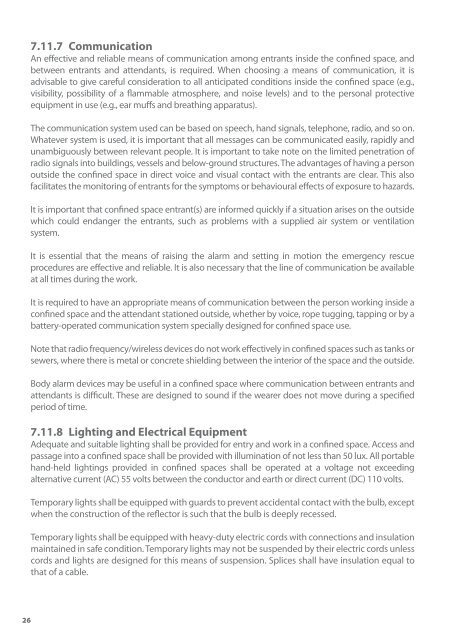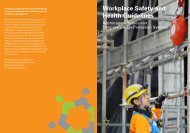Confined Spaces - Workplace Safety and Health Council
Confined Spaces - Workplace Safety and Health Council
Confined Spaces - Workplace Safety and Health Council
- No tags were found...
Create successful ePaper yourself
Turn your PDF publications into a flip-book with our unique Google optimized e-Paper software.
7.11.7 CommunicationAn effective <strong>and</strong> reliable means of communication among entrants inside the confined space, <strong>and</strong>between entrants <strong>and</strong> attendants, is required. When choosing a means of communication, it isadvisable to give careful consideration to all anticipated conditions inside the confined space (e.g.,visibility, possibility of a flammable atmosphere, <strong>and</strong> noise levels) <strong>and</strong> to the personal protectiveequipment in use (e.g., ear muffs <strong>and</strong> breathing apparatus).The communication system used can be based on speech, h<strong>and</strong> signals, telephone, radio, <strong>and</strong> so on.Whatever system is used, it is important that all messages can be communicated easily, rapidly <strong>and</strong>unambiguously between relevant people. It is important to take note on the limited penetration ofradio signals into buildings, vessels <strong>and</strong> below-ground structures. The advantages of having a personoutside the confined space in direct voice <strong>and</strong> visual contact with the entrants are clear. This alsofacilitates the monitoring of entrants for the symptoms or behavioural effects of exposure to hazards.It is important that confined space entrant(s) are informed quickly if a situation arises on the outsidewhich could endanger the entrants, such as problems with a supplied air system or ventilationsystem.It is essential that the means of raising the alarm <strong>and</strong> setting in motion the emergency rescueprocedures are effective <strong>and</strong> reliable. It is also necessary that the line of communication be availableat all times during the work.It is required to have an appropriate means of communication between the person working inside aconfined space <strong>and</strong> the attendant stationed outside, whether by voice, rope tugging, tapping or by abattery-operated communication system specially designed for confined space use.Note that radio frequency/wireless devices do not work effectively in confined spaces such as tanks orsewers, where there is metal or concrete shielding between the interior of the space <strong>and</strong> the outside.Body alarm devices may be useful in a confined space where communication between entrants <strong>and</strong>attendants is difficult. These are designed to sound if the wearer does not move during a specifiedperiod of time.7.11.8 Lighting <strong>and</strong> Electrical EquipmentAdequate <strong>and</strong> suitable lighting shall be provided for entry <strong>and</strong> work in a confined space. Access <strong>and</strong>passage into a confined space shall be provided with illumination of not less than 50 lux. All portableh<strong>and</strong>-held lightings provided in confined spaces shall be operated at a voltage not exceedingalternative current (AC) 55 volts between the conductor <strong>and</strong> earth or direct current (DC) 110 volts.Temporary lights shall be equipped with guards to prevent accidental contact with the bulb, exceptwhen the construction of the reflector is such that the bulb is deeply recessed.Temporary lights shall be equipped with heavy-duty electric cords with connections <strong>and</strong> insulationmaintained in safe condition. Temporary lights may not be suspended by their electric cords unlesscords <strong>and</strong> lights are designed for this means of suspension. Splices shall have insulation equal tothat of a cable.Temporary lights <strong>and</strong> electrical services should be protected by an earth leakage circuit breaker(ELCB).Working spaces, walkways, <strong>and</strong> similar locations shall be kept clear of cords so as not to create ahazard to workers. All electrical equipment should be protected by an ELCB.For details on lighting of work place, kindly refer to Singapore St<strong>and</strong>ard, SS531 : Part 1 toPart 3.7.11.9 Respiratory Protective Equipment7.11.9.1 General Guidelines on Selection of Respiratory Protective EquipmentIt is recommended that respiratory protective equipment (RPE) be used as a last resort when allof the other control measures in the hierarchy of control are either inadequate or impractical, orin the event of an emergency where entry is required for rescue purposes.The authorised manager is advised to always aim to achieve a safe atmosphere where respiratoryprotective equipment would not be necessary. If this is not practicable, appropriate respiratoryprotective equipment should be considered depending on the likely concentration ofcontaminant <strong>and</strong>/or oxygen level in the confined atmosphere.Respirators are devices that allow workers to breathe safely without inhaling harmful levels oftoxic gases or particles. It is critical to have a competent person to determine the appropriaterespiratory protective equipment based upon conditions <strong>and</strong> test results of the atmosphere <strong>and</strong>the work activity to be performed. It is important that the breathing apparatus fits properly <strong>and</strong> issafe to use. Care needs to be taken in the selection of the device <strong>and</strong> in its use. It is also importantnot to use any damaged or defective protective devices.Selection of respiratory protective devices is generally based on:• Type of air contaminants present (i.e., articles, vapours, gases);• Hazard of exposure (i.e., IDLH, eye irritant, Toxicity);• Warning properties of contaminants;• Level of exposure;• Exposure time;• Work activity;• Characteristics <strong>and</strong> limitations of the respirator equipment; <strong>and</strong>• Level of protection needed.For details on selection, use <strong>and</strong> maintenance of respiratory protective devices, kindlyrefer to Singapore St<strong>and</strong>ard, SS548 : 2009 Code of Practice for Selection, Use, Care <strong>and</strong>Maintenance of Respiratory Protective Devices.26 27
















